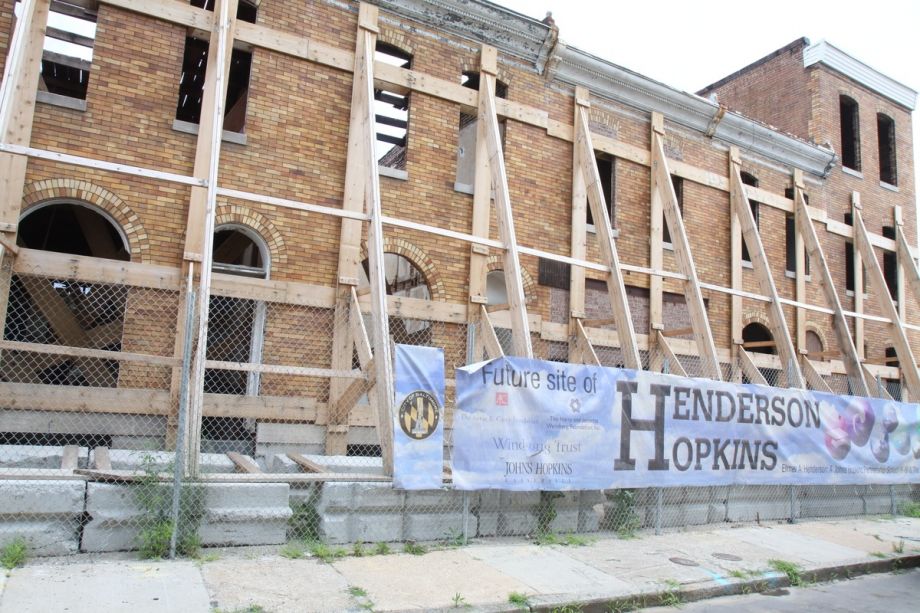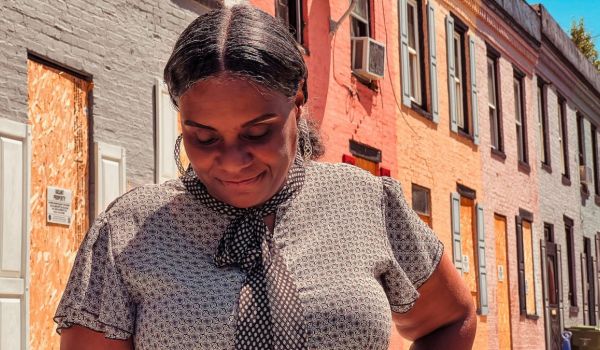The latest redevelopment promise for East Baltimore has grown entangled with the same racial tension and accusations of corruption that underscore much of the history between the community and Johns Hopkins. But as Dax-Devlon Ross discovers in this week’s Forefront, things could turn out differently this time around.
“If EBDI fails, then my presidency at Hopkins fails.” With those nine words, Ronald J. Daniels, 14th president of the world’s leading medical institution, staked his legacy on an urban renewal project that, a decade in, many believed was too entangled in racial tensions, accusations and financial setbacks to salvage.
The event that occasioned Daniels’ intrepid declaration was a February 2012 board meeting of the Baltimore Development Corporation. BDC oversaw downtown development while East Baltimore Development Incorporated (EBDI), in essence its younger sibling, had been created 10 years prior by Johns Hopkins University, the Annie E. Casey Foundation and then-mayor Martin O’Malley. The development organization’s sole mission was to ensure the progress of a $1.8 billion facelift for an 88-acre neighborhood, known as Middle East by its African-American residents, just north of Hopkins’ downtown hospital.
It’s a rare day when the leader of a private institution openly acknowledges its moral obligation to “share our bounty” with the public, let alone hold himself personally and professionally accountable to do so. After all, town-gown tensions trace back to the Middle Ages and continue to be a common feature on campuses across the country. Many schools have enacted policies and programs to address the disparities between the university and the surrounding community. But let’s be honest — a college president’s success is typically judged by his or her ability to raise an institution’s profile, ranking, enrollment and endowment, not the degree to which he fixes the surrounding community.
In other words, as good as Daniels’s intentions might’ve been, they would have seemed gratuitous, unless you knew the context in which they were situated.
A little more than a year earlier, the Daily Record, Baltimore’s prize-winning business publication, had published a damning five-part investigative series on EBDI by Melody Simmons and Joan Jacobson. Titled “Too Big to Fail? Betting a Billion on East Baltimore,” the series painted a picture of a ballyhooed urban revitalization project gone terribly awry. The piece reported that few contracts had been issued to minority businesses and even fewer jobs had been created for East Baltimore residents. Meanwhile, the organization’s executives and its pricey consultants had been hauling in hefty salaries and commissions for close to a decade without any public oversight due to EBDI’s non-profit status. Nearly all of Middle East’s residents had been removed and more than half a billion dollars in public and private money had been poured into the project. However, 700 abandoned homes still stood and plans for the 1.1 million-square-foot biotech park, which EBDI promised would produce nearly 7,000 permanent jobs and resuscitate the neighborhood, appeared stuck. A 30-acre rectangle consisting of a lone biotech building, a couple of hundred rental units for seniors, a handful of condos, an unfinished graduate student housing facility and an incomplete parking garage were all EBDI had to show.
The series became a rallying point for an assortment of the controversial project’s detractors — people who thought it unfairly targeted minorities for removal, or excluded minorities from contracts, or enriched outsiders at the expense of the public, or unfairly benefited Hopkins or East Baltimore, or was simply just a bad idea. Though the piece never identified a smoking gun, it hinted at grave wrongdoing. The project had overpromised and underdelivered. In a city that was already a modern-day symbol of municipal incompetence, even the whiff of corruption stirred an outcry. Protests ensued. A group of indignant African-American leaders called for a halt to all work until a thorough investigation had been completed. Elected officials called EBDI to City Hall for a pair of public hearings on the project.
It was against this arguably desperate backdrop that Daniels made his remarks. But perhaps even more unexpected than the Hopkins president’s commitment to the redevelopment’s success was the tool he planned on using to get there: A struggling public elementary school that had only been in existence for two years, didn’t have a permanent home and didn’t appear in EBDI’s original plan.
“In an environment where human and financial resources are strained, choices such as these are unavoidable,” Daniels said in a speech at Hopkins’ gleaming new Carey Business School on the Harbor East waterfront. “And it was in this context that we elevated the rejuvenation of the school as a core priority for EBDI — as well as for the university. We did so because the school stands as a poignant, vivid and galvanizing place for us to demonstrate our core belief in the community and its future.”
With its campus of temporary trailers, below-average test scores and 90 percent low-income student body, East Baltimore Community School now held the key to EBDI’s $1.8 billion gamble. Under Hopkins’ wing, the school would attract young, middle-class families to the community. Those families would in turn bolster the housing market and attract businesses and outside investment. In short order the neighborhood would be thriving again. There were signs that school-centered community revitalization was an untapped frontier. Columbia, Md.-based Enterprise Community Partners had published a report highlighting an assortment of piecemeal initiatives around the country. They were a mixed bag. Some were redevelopment that included brand new schools built from the ground up; others were school reform projects intended to catalyze neighborhood transformation. Still others were public housing redevelopment projects that leveraged federal housing subsidies to develop new education programs or charter schools. None were tied to such a massive, high-stakes urban renewal undertaking.
To demonstrate how serious Hopkins was, Daniels laid out his vision. Not only would Hopkins be recruiting the teachers and designing the curricula, but Daniels was throwing the full weight of the institution’s vast intellectual stockpile behind its success.
“In addition to the school of education’s prominent footprint,” Daniels told the audience, “the medical institutions will offer mental health counseling and family support services, the Peabody Conservatory will operate a prep branch out the school, the Center for Talented Youth will work with high-achieving students and the athletics department will run after-school programs.”
The showstopper was the school’s new home. In fall 2013 it would take up residence along with the Weinberg Early Childhood Center on a 90,000-square-foot campus inside the freshly reborn neighborhood’s footprint. The renderings offered a thrilling glimpse into a possible future of public, primary education — atriums gushing sunlight, lush green spaces, open classrooms, leisure areas, stock images of children from all races with their arms draped around each other. It would house a gym, auditorium, family resource center and library, all open to the community.
The school would “fundamentally change the way we educate children,” the narrator of a promotional video promised. None of that comes cheap. A tax increment financing agreement — which would divert tax revenue generated in the 88 acres from the city’s general fund and, instead, allow it to stay within the district to support development costs — would cover the $25 million land clearing price tag on the school site. Private investors, including Casey and Hopkins, would foot the $42 million in construction costs. Once completed, Hopkins would contribute $1.5 million annually in operating funds. The school would be a public-private partnership, with Hopkins and EBDI at one end and the Baltimore City Public School system at the other.
The belief in local “anchor” institutions — in this case, Johns Hopkins and its partner school — as primary partners for urban revitalization has been gaining currency in policy circles for more than a decade, with most analysts focusing on the power of so-called “eds and meds,” like Hopkins. Nationally, this category of “eds and meds,” including hospitals, universities and research centers, is credited with providing 11 percent of all inner-city jobs, according to a 2011 report issued by the Initiative for a Competitive Inner City. When leveraged properly — meaning when they intentionally engage their local economies — anchors stimulate local businesses, support economic equity for disadvantaged groups and even create environmentally friendly businesses such as local food producers and community-based clean energy and weatherization companies. Oh, and they tend to stay put, hence the “anchor” tag.
But how on earth could an unproven school in a city renowned for its broken, segregated public education system serve as the anchor for a diverse, mixed-income community’s revitalization?
To read more, subscribe to Forefront. Already a subscriber? Click here to continue reading.
















